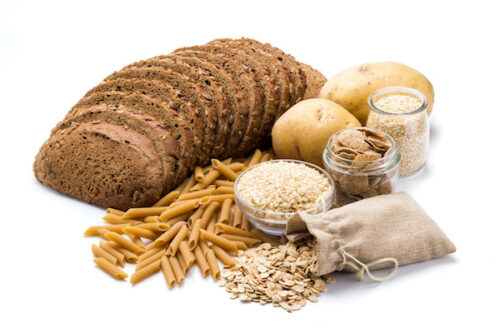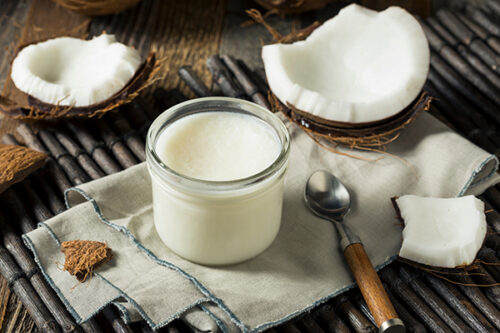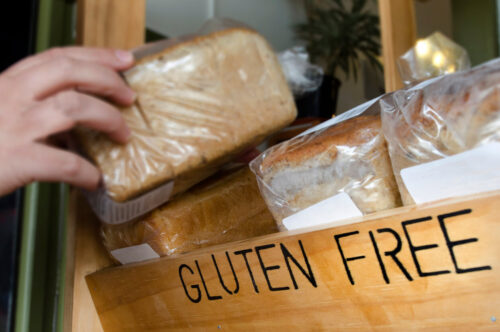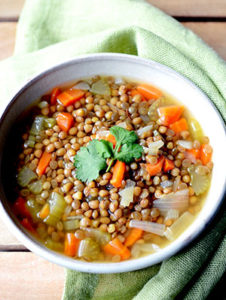The “Eat More Starch” Challenge: Eat 12 Slices of Bread Daily to Lose 10 Pounds Monthly

This article originally appeared in the December 2011 McDougall Newsletter.
By John McDougall, MD
In 1979, researchers from the Food Science and Human Nutrition Department at Michigan State University (my alma mater) reported the results from asking 16 moderately overweight college-age men to add 12 slices of white bread (at 70 calories a slice) or high-fiber bread (at 50 calories a slice) to their diet daily.1 On average, subjects eating the extra white bread lost 14 pounds (6.26 Kg) and those adding the high-fiber bread lost 19 pounds (8.77 Kg) over the next eight weeks. There was no change in their physical activity or exercise. “Thus, weight loss of both groups of subjects occurred without alteration in lifestyle except for the supplementation of food intake with breads,” according to these investigators. (You might want to read this entire study.)
The health of these college students also improved as reflected by the very rapid reduction in blood cholesterol levels by an average of 60 and 80 mg/dL in the first few days of eating bread. (From 223.6 to 172.3 mg/dL with the high-fiber bread addition and from 231.4 to 155.3 mg/dL on the white bread diet. The reason for a greater reduction in cholesterol on the white bread was not explained.) The students on the high-fiber bread, as expected, had more frequent and larger bowel movements than those on the white-bread diet. (If this single article had been given deserved attention the world and its inhabitants would be in a much better condition today.)
A Time for Positive Action
Okay, I get it after 54 years in medicine; I, John McDougall, MD, can’t convert everyone to a healthier diet with my recommendations to abandon all animal foods and oils at the dinner table. Perhaps people do not respond to negative comments such as “don’t eat this or that.” Maybe a better answer is to give positive instructions to eat more of their favorite foods. Starches, like rice, corn, potatoes, pastas, and breads are so universally cherished that they are individually and collectively referred to as “comfort foods.” However, most people are unaware of the power of starches to cause them effortless loss of excess weight and to restore their health. Even after becoming fully informed, many “true believers” are still unwilling to fully pledge to the McDougall Diet at this time. But that does not change the obvious: that they would benefit from eating healthier. As a dedicated doctor, I will not abandon the sick and needy. To learn more about the miracles of corn, potatoes, rice and wheat read my national bestselling book the Starch Solution.
In this context, my recommendation to help people who are gaining more weight and losing more health is to not intentionally give up any of the foods that they currently love: do not stop eating eggs Benedict, hot dogs topped with beef chili, pepperoni pizza, fried chicken, or ice cream sundaes. Instead, I ask them to pledge to make one—and only one—addition to their diet: Eat more starch. Just add an extra 600 to 900 calories of starchy comfort foods daily, like the college men in the study did, in order to see similar remarkable benefits.
This commitment means adding any one of the following to your regular diet:
3 to 4 cups of steamed rice
3 to 4 cups of boiled corn
3 to 4 mashed potatoes
3 to 4 baked sweet potatoes
3 to 4 cups of boiled spaghetti noodles
6 to 12 slices of fresh bread
You can mix and match any kind of whole grains or starchy vegetables to make up these additional 600 to 900 calories daily. The effect of adding these appetite-satisfying, nutritious choices will be to displace fattening and sickening foods (meats, dairy products, and oils). Spontaneously, without any conscious thought, your intake of calories, fat, cholesterol, and chemical contaminants will diminish and fiber, vitamins, minerals, and carbohydrate will increase.
Starches Satisfy Our Appetite
The authors of this landmark study wrote, “Reasonable amounts of bread consumed with the meal provided an increased quantity of bulk before the individual has a chance to consume his usual intake of calories. High-fiber bread may be more effective in this regard since one characteristic of cellulose is its ability to absorb water with a consequent increase in volume. This may explain the ability of the subjects receiving the reduced-calorie bread to consume only two-thirds of their usual calorie intake without experiencing any severe hunger pains.” By adding the bread, the college students were able to spontaneously reduce their average daily intake by 850 calories (3,200 to 2,350) for white bread and 1,325 calories (3,200 to 1,975) for high-fiber bread.
Appetite satisfaction begins with physically filling the stomach. Compared to cheese (four calories per gram), meat (four calories per gram), and oils (nine calories per gram), starches (at only one calorie per gram) are very calorie dilute. In the simplest terms, starches will physically fill you up with a fraction of the calories.2 Furthermore, research comparing the impact of eating carbohydrates and fats on the appeasement of our appetite shows carbohydrates lead to long-term satiety, enduring for hours between meals, whereas the fats in a meal have little impact on satiety. People are left wanting more food when they eat fats and oils.3,4
The authors of this study concluded, “Bread itself is not high in calories. It can be reasoned that it curbs hunger pangs, enabling the dieter to resist foods that otherwise would cause excessive caloric intake.” There was some adjustment during the eight-week study. At the beginning, even though they were allowed to continue to eat their usual food choices in unlimited quantities, almost all subjects felt hungry. However, by completion at eight weeks, the subjects consuming the high-fiber bread indicated that they were not hungry at any time.
White vs. Brown Rice and Brown Bread
Whole foods are healthier than refined foods for people in most circumstances. The extra dietary fiber has many benefits, including improved bowel function, greater reduction in cholesterol, triglycerides, and blood sugars, and better weight loss (as this study showed). However, the fear of “white” is overrated and has caused experts to overstate the role of refined foods in the current epidemics of obesity, type-2 diabetes, and heart disease. Consider this undeniable observation: There are 1.73 billion Asians living on polished white rice worldwide and they are not overweight or obese. However, most lose this immunity with their immigration and assimilation into western societies and the replacement of rice for meat and dairy foods.
Switching to unrefined foods, like brown rice, is impractical for many people because these choices are less available and sometimes costlier. In the past eating refined foods has defined social class. Traditionally in Asian countries, wealthier people could afford white rice, but the poor people had to eat the less expensive brown rice. Many of my Japanese, Chinese, and Filipino patients have refused to eat brown rice because of bigotry. My solution has been a trade-off: Stick with your favorite white rice, but eliminate the most damaging culprits: meats, dairy products, and oils.
The most effective diet ever reported for obesity and recovery from failing hearts and kidneys is based on white rice.5 The Kempner Diet, associated with Duke University for the past seventy years, has also cured thousands of people with severe hypertension, type-2 diabetes, and inflammatory arthritis. White rice was preferred because of familiarity and palatability among patients.
Perfection Is Not the Only Answer
If you are still struggling to follow my recommendations, for now take a pledge to do nothing more than eat more starch. Buy a loaf of whole wheat bread (with no added fat, milk, or eggs in the ingredients) every day and eat it all. What could be simpler? Tired of bread, then buy rice. Although not ideal, even white rice will work. Frozen, already cooked rice, corn, and peas are available in plastic bags. Just reheat in the microwave. Uncooked, shredded potatoes can be quickly “fried up” with no oil in a non-stick pan. Canned and bottled beans make a quick meal. With the rules of the “Eat More Starch” challenge, you could pour bacon grease, butter, cheese, and baby back ribs over your hash browns and still be better off than you were without the 600 to 900 calories of additional starch. After all, these college men lost considerable weight and reduced their cholesterol by simply adding more bread to their standard American diets.
The McDougall Diet is a tool, not a religion—the benefits are not “all or nothing.” However, I hope that once you experience the healing power of starches you will become greedy and want all the good health you can get. With undeniable proof from a couple of months of additional rice and potatoes, you should eventually make starches 75 to 90 percent of your diet, with the remainder coming from fruits and vegetables—and one day soon, forgo all the meat, dairy, and vegetable oils. Your adjustment will be quicker and easier than you ever imagined, you will enjoy your foods, and you will be thrilled with the results.
References:
1) Mickelsen O, Makdani DD, Cotton RH, Titcomb ST, Colmey JC, Gatty R. Effects of a high fiber bread diet on weight loss in college-age males. Am J Clin Nutr. 1979 Aug;32(8):1703-9.
2) Rolls BJ. The role of energy density in the overconsumption of fat. J Nutr. 2000 Feb;130(2S Suppl):268S-271S.
3) Blundell JE, Lawton CL, Cotton JR, Macdiarmid JI. Control of human appetite: implications for the intake of dietary fat. Annu Rev Nutr. 1996;16:285-319.
4) Rolls BJ, Kim-Harris S, Fischman MW, Foltin RW, Moran TH, Stoner SA. Satiety after preloads with different amounts of fat and carbohydrate: implications for obesity. Am J Clin Nutr. 1994 Oct;60(4):476-87. Annu Rev Nutr. 1996;16:285-319.
5) Kempner W, Newborg BC, Peschel RL, Skyler JS. Treatment of massive obesity with rice/reduction diet program. An analysis of 106 patients with at least a 45-kg weight loss. Arch Intern Med. 1975 Dec;135(12):1575-84.
Recommended Articles

The Real Coconut Oil Miracle: How a High-Fat, High-Calorie Condiment Became a “Superfood”

Gluten-Free Diets Are Harmful for the General Population (Except for One Percent)







